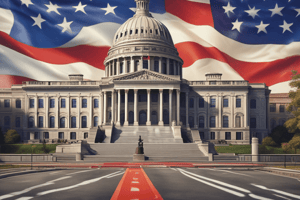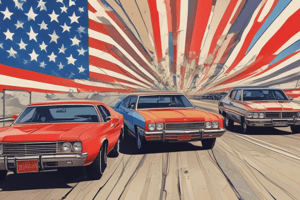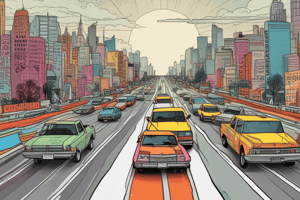Podcast
Questions and Answers
What is a characteristic of local actors in civil wars compared to central actors?
What is a characteristic of local actors in civil wars compared to central actors?
- Local actors exclusively follow central actors' commands.
- Local actors are less organized than central actors.
- Local actors may have different motivations from central leaders. (correct)
- Local actors always mirror the ideologies of central actors.
Which of the following factors is NOT mentioned as a legitimate reason individuals fight in civil wars?
Which of the following factors is NOT mentioned as a legitimate reason individuals fight in civil wars?
- Fear or coercion
- Religious beliefs (correct)
- Ideological alignment
- Private motivations
How do rebel groups generally emerge during a civil war according to the content?
How do rebel groups generally emerge during a civil war according to the content?
- From centralized command structures.
- Through dialogue with government forces.
- As a response to aggregated local violence. (correct)
- By recruiting only individuals committed to their ideology.
In the context of civil wars, what does the term 'free-riding' refer to?
In the context of civil wars, what does the term 'free-riding' refer to?
What does the observation of ambiguous identities in civil wars suggest?
What does the observation of ambiguous identities in civil wars suggest?
Which of the following statements best describes the macro vs micro dynamics of civil war participation?
Which of the following statements best describes the macro vs micro dynamics of civil war participation?
Which evidence supports the notion that multiple motivations can drive individuals to join insurgencies?
Which evidence supports the notion that multiple motivations can drive individuals to join insurgencies?
What technique do rebels use to solve the problems posed by free-riding?
What technique do rebels use to solve the problems posed by free-riding?
What is a characteristic of intrastate wars compared to interstate wars?
What is a characteristic of intrastate wars compared to interstate wars?
Which aspect distinguishes the dynamics of intrastate wars from interstate wars?
Which aspect distinguishes the dynamics of intrastate wars from interstate wars?
What is implied by the term 'macro-dynamics' in the context of wars?
What is implied by the term 'macro-dynamics' in the context of wars?
Which statement best reflects micro-dynamics in intrastate conflicts?
Which statement best reflects micro-dynamics in intrastate conflicts?
Why might local violence in intrastate wars deviate from overall conflict patterns?
Why might local violence in intrastate wars deviate from overall conflict patterns?
Which of the following best describes 'intimate violence' in intrastate wars?
Which of the following best describes 'intimate violence' in intrastate wars?
How do macro-and micro-dynamics affect war outcomes?
How do macro-and micro-dynamics affect war outcomes?
Which statement is correct regarding the comparison between intrastate and interstate wars?
Which statement is correct regarding the comparison between intrastate and interstate wars?
What differentiates intrastate wars from interstate wars?
What differentiates intrastate wars from interstate wars?
What is a common characteristic of civil or ethnic wars?
What is a common characteristic of civil or ethnic wars?
Which of the following accurately reflects the trend in intrastate wars since the 1990s?
Which of the following accurately reflects the trend in intrastate wars since the 1990s?
Which of the following types of intrastate war is characterized by one-sided violence aimed at eliminating a particular group?
Which of the following types of intrastate war is characterized by one-sided violence aimed at eliminating a particular group?
What challenge is commonly faced when identifying combatants in intrastate wars?
What challenge is commonly faced when identifying combatants in intrastate wars?
What does the concept of 'micro-dynamics' in violence refer to?
What does the concept of 'micro-dynamics' in violence refer to?
In what way do the dynamics post-intrastate war differ from those post-interstate war?
In what way do the dynamics post-intrastate war differ from those post-interstate war?
What major factor contributes to the increasing lethality of recent intrastate wars?
What major factor contributes to the increasing lethality of recent intrastate wars?
Study Notes
Understanding Intrastate Conflict
- Intrastate conflicts are not solely driven by religious, ethnic, or class divisions.
- To understand intrastate conflict, we need to examine individual motivations, how individuals mobilize others, and how they sustain their activities.
- Intrastate wars are complex and ambiguous processes with diverse actors.
- This complexity allows civilians to survive.
- Local fights often escalate into larger political conflicts.
- Rebel groups often emerge from war.
- Most fighters may not even support the primary ideology of the rebel group.
- Individuals may join insurgencies for various reasons, including coercion and fear.
- Free-riding and coordination issues are common challenges for rebel groups.
- Civilian mortality is heavily impacted by intrastate wars.
- Infectious diseases, infrastructure breakdown, and transportation accidents are all contributing factors to increased mortality rates.
Intrastate War Dynamics
- Intrastate wars are the dominant form of conflict globally.
- More intrastate wars start than end.
- Intrastate wars have become more bloody.
- Civilians are frequently targeted, and sometimes entire populations are targeted.
- Intrastate wars often last longer than interstate wars.
- This combination of factors contributes to higher casualties in intrastate wars.
- Intrastate wars involve intimate violence.
Micro vs Macro Dynamics
- In interstate wars, all units must operate in service of a broader strategy, with centralized command.
- In intrastate wars, there may be a disconnect between micro-level actions and the overall strategy.
- This difference can affect war outcomes.
Types of Intrastate War
- There are three primary types of intrastate wars:
- Civil/ethnic war: War between the government and groups seeking a change in their status
- Revolutionary war: War between the government and armed groups seeking control of the state.
- Ethnic cleansing/genocide: One-sided violence to eliminate a group.
Recent Trends
- Intrastate wars are accumulating over time.
- However, the number of wars started decline in the 1990s.
- There has been a recent uptick in intrastate wars, and their lethality is increasing.
- The nature of intrastate conflicts has shifted, with a decline in ethnic wars.
Studying That Suits You
Use AI to generate personalized quizzes and flashcards to suit your learning preferences.
Related Documents
Description
This quiz explores the complexities of intrastate conflict, emphasizing the individual motivations and dynamics that influence these wars. It delves into how local fights can escalate into broader political struggles and the various factors that affect civilian mortality during these conflicts. Join to deepen your understanding of the multifaceted nature of intrastate warfare.




